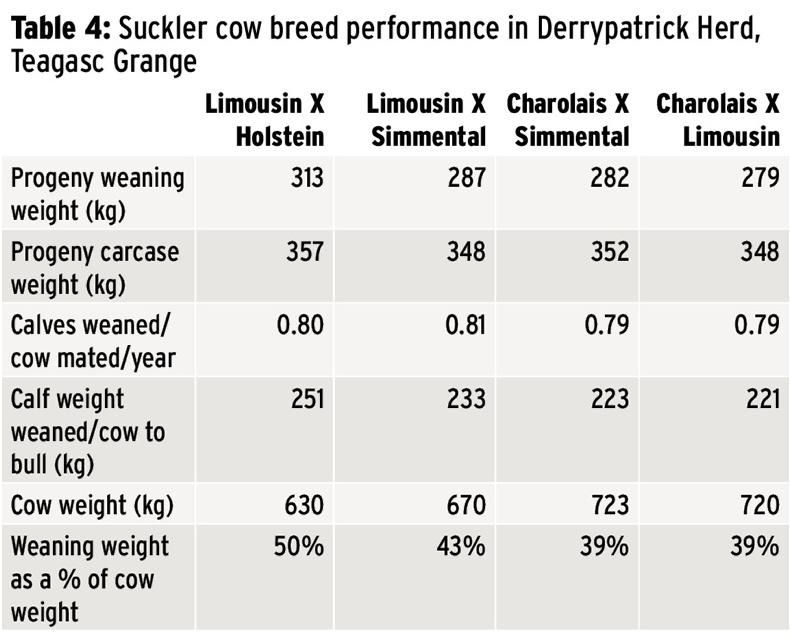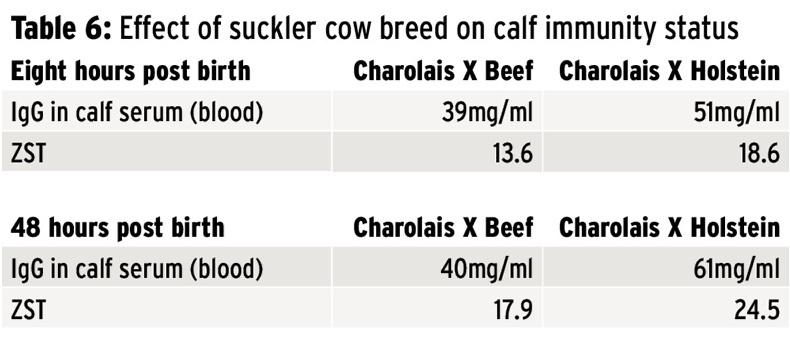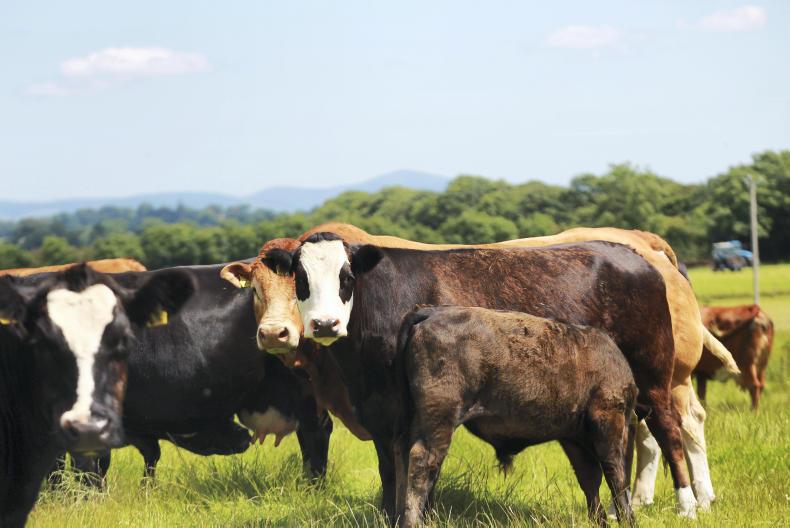Cow type and greenhouse gases
Table 4 summarises four years of trial work from phase one of the Derrypatrick herd at Teagasc Grange, where four suckler cow types were evaluated. Charolais and Limousin sires were used in the study and progeny were slaughtered as 18-month bulls or 20-month heifers. Reproductive efficiency was similar across all cow types but the Lim X Ho cows produced the heaviest weanlings and had the highest weaning efficiency. In addition, despite their genetics, the progeny from these cows (Lim x Ho) produced the heaviest carcases ten months later – calves from more terminal cows did not “catch up”. This shows the importance of milk in a suckler herd.

The trial outlined in Tables 5 and 6 compared colostrum yield, quality and effectiveness in beef and dairy-cross suckler cows. Immunoglobulins (IgG) are antibodies and ZST measures the efficiency of IgG transfer between cow and calf – bigger figures are better for both. The dairy-cross cows performed best for all of the important variables.


Greenhouse gas emissions and energy requirements
The figures for greenhouse gas emissions below are for total emissions and include the production, processing and transportation of feeds to farms.
National average suckler-to-beef farm (spring-calving, 30-month steer, 26-month heifer): 26.4kg CO2 emissions per kg beef – highest.Moderately-stocked (2.2LU/ha) steer-producing farm (spring-calving, 24-months steer, 20-month heifer): 22.6kg CO2eHighly-stocked (2.9LU/ha) steer-producing farm (spring-calving, 24-months steer, 20-month heifer): 25.6kg CO2e
Moderately-stocked (2.2LU/ha) bull-producing farm (spring-calving, under-16-month bull, 20-month heifer): 21.7kg CO2e – lowestHighly-stocked (2.9LU/ha) bull-producing farm (spring-calving, under-16-month bull, 20-month heifer): 23.6kg CO2eLessons from the research:
Greenhouse gas emissions per kg of beef are lowest in suckler bull beef systems.Introducing dairy genetics (milk) into a suckler herd will lead to benefits in terms of better calf immunity and improved weaning weights, weaning efficiency and carcase weights.References
McGee, Mark, Michael J Drennan, and Patrick J Caffrey. "Effect of suckler cow genotype on cow serum immunoglobulin (Ig) levels, colostrum yield, composition and Ig concentration and subsequent immune status of their progeny." (2005)
Crosson, P, L Shalloo, D O’Brien, GJ Lanigan, PA Foley, TM Boland, and DA Kenny. "A review of whole farm systems models of greenhouse gas emissions from beef and dairy cattle production systems." (2011)
McWeeney, L, Minogue, D, Crossan, P, Prendiville, R, and P French. “Update on the Derrypatrick Herd (Comparison of continental bred suckler cow breed types)” (2014)
Read more
Part one: suckler series – what does the research say?
Cow type and greenhouse gases
Table 4 summarises four years of trial work from phase one of the Derrypatrick herd at Teagasc Grange, where four suckler cow types were evaluated. Charolais and Limousin sires were used in the study and progeny were slaughtered as 18-month bulls or 20-month heifers. Reproductive efficiency was similar across all cow types but the Lim X Ho cows produced the heaviest weanlings and had the highest weaning efficiency. In addition, despite their genetics, the progeny from these cows (Lim x Ho) produced the heaviest carcases ten months later – calves from more terminal cows did not “catch up”. This shows the importance of milk in a suckler herd.

The trial outlined in Tables 5 and 6 compared colostrum yield, quality and effectiveness in beef and dairy-cross suckler cows. Immunoglobulins (IgG) are antibodies and ZST measures the efficiency of IgG transfer between cow and calf – bigger figures are better for both. The dairy-cross cows performed best for all of the important variables.


Greenhouse gas emissions and energy requirements
The figures for greenhouse gas emissions below are for total emissions and include the production, processing and transportation of feeds to farms.
National average suckler-to-beef farm (spring-calving, 30-month steer, 26-month heifer): 26.4kg CO2 emissions per kg beef – highest.Moderately-stocked (2.2LU/ha) steer-producing farm (spring-calving, 24-months steer, 20-month heifer): 22.6kg CO2eHighly-stocked (2.9LU/ha) steer-producing farm (spring-calving, 24-months steer, 20-month heifer): 25.6kg CO2e Moderately-stocked (2.2LU/ha) bull-producing farm (spring-calving, under-16-month bull, 20-month heifer): 21.7kg CO2e – lowestHighly-stocked (2.9LU/ha) bull-producing farm (spring-calving, under-16-month bull, 20-month heifer): 23.6kg CO2eLessons from the research:
Greenhouse gas emissions per kg of beef are lowest in suckler bull beef systems.Introducing dairy genetics (milk) into a suckler herd will lead to benefits in terms of better calf immunity and improved weaning weights, weaning efficiency and carcase weights.References
McGee, Mark, Michael J Drennan, and Patrick J Caffrey. "Effect of suckler cow genotype on cow serum immunoglobulin (Ig) levels, colostrum yield, composition and Ig concentration and subsequent immune status of their progeny." (2005)
Crosson, P, L Shalloo, D O’Brien, GJ Lanigan, PA Foley, TM Boland, and DA Kenny. "A review of whole farm systems models of greenhouse gas emissions from beef and dairy cattle production systems." (2011)
McWeeney, L, Minogue, D, Crossan, P, Prendiville, R, and P French. “Update on the Derrypatrick Herd (Comparison of continental bred suckler cow breed types)” (2014)
Read more
Part one: suckler series – what does the research say?









 This is a subscriber-only article
This is a subscriber-only article








SHARING OPTIONS: